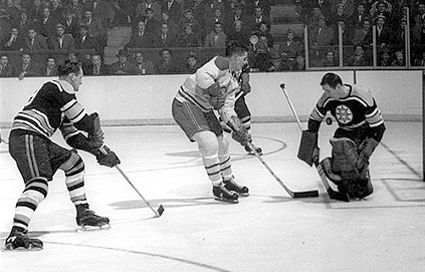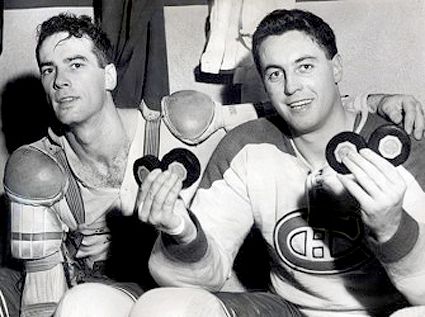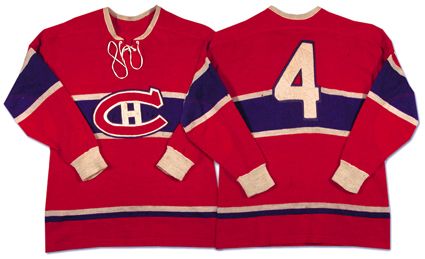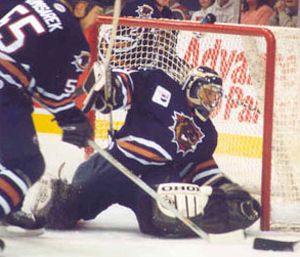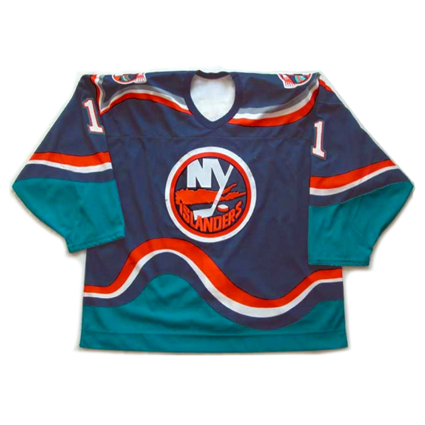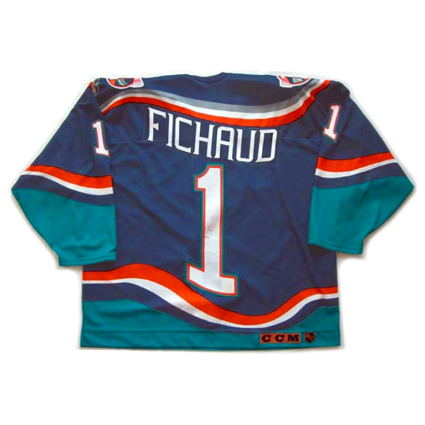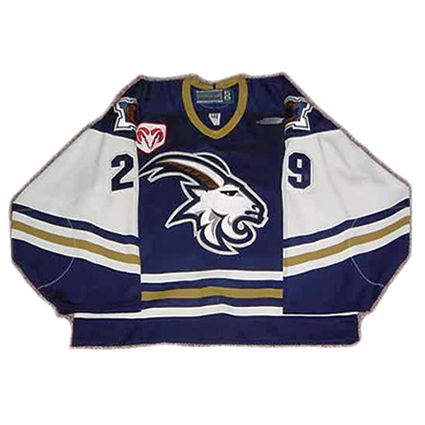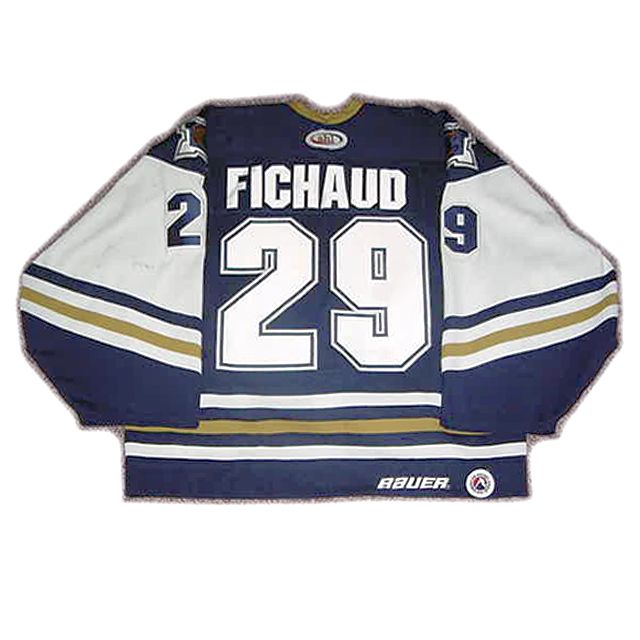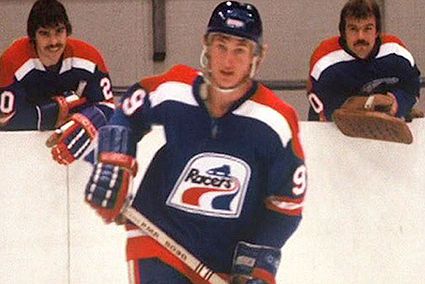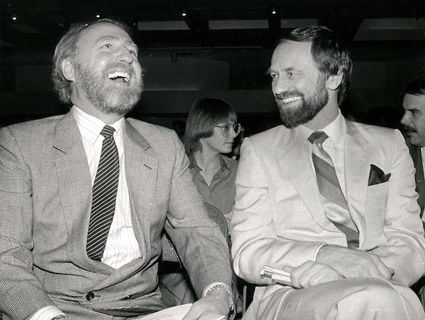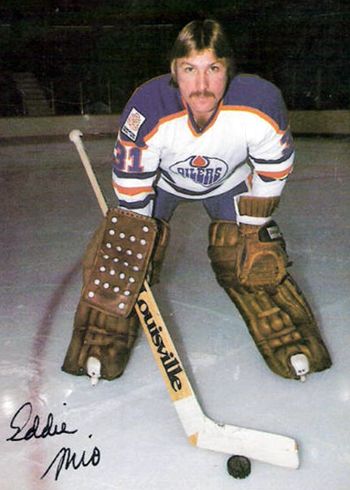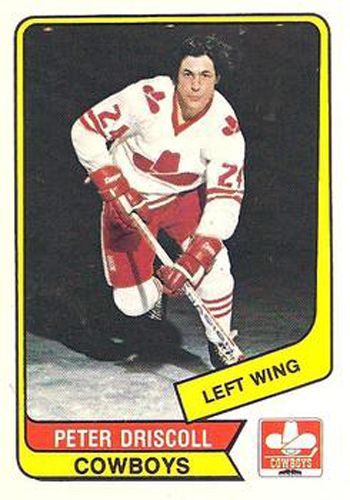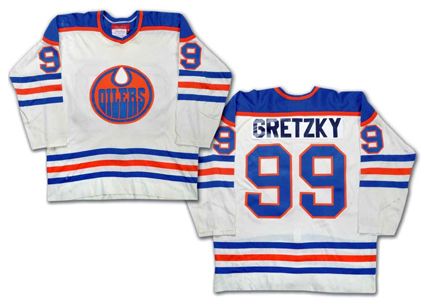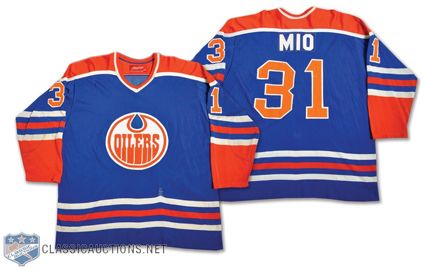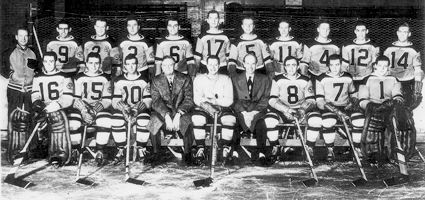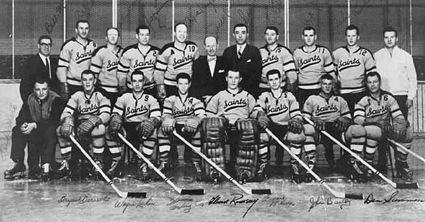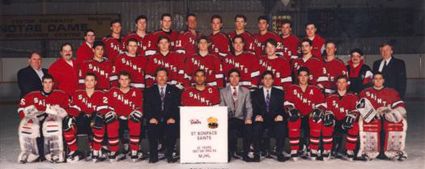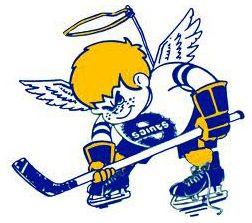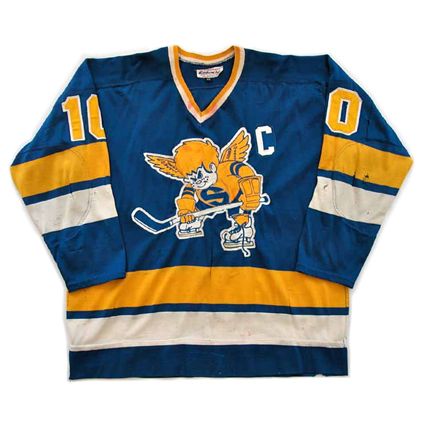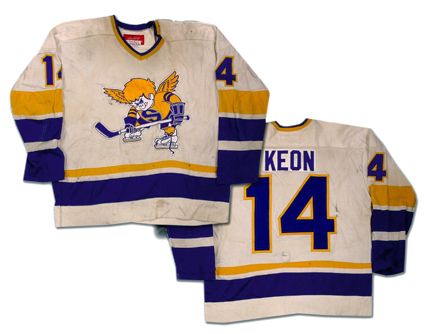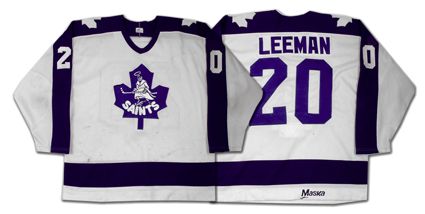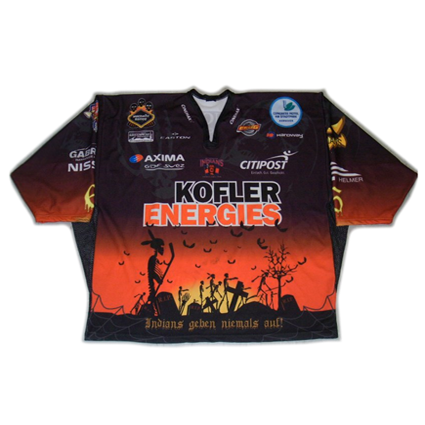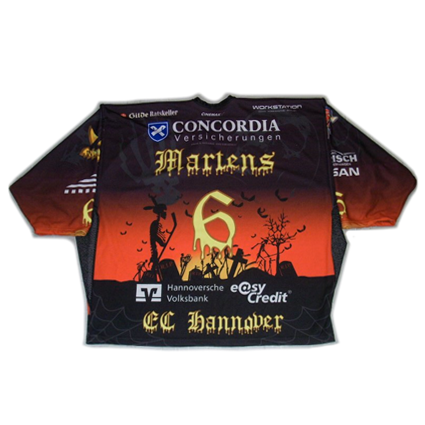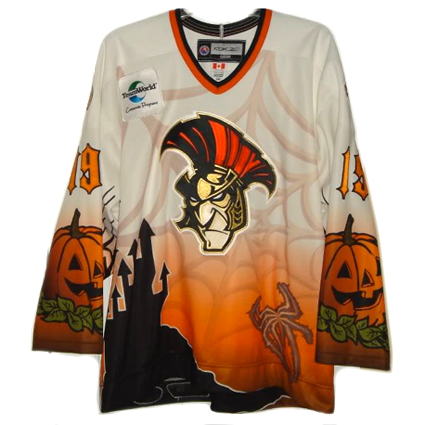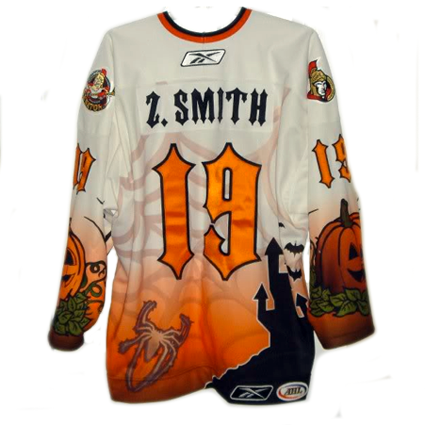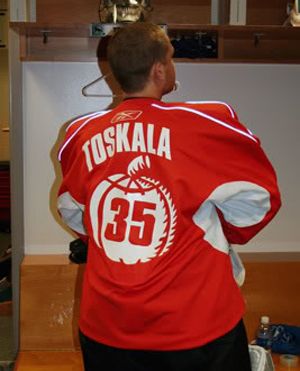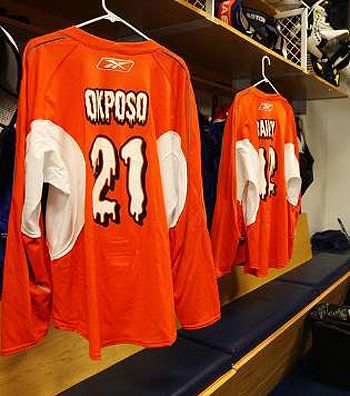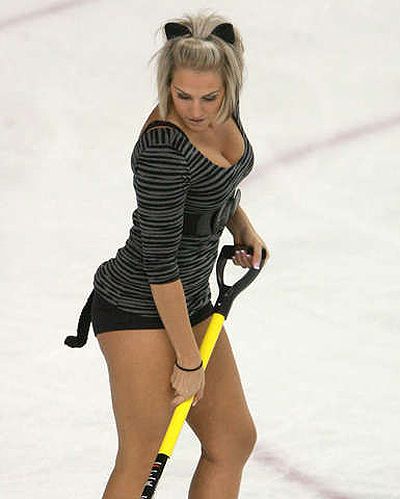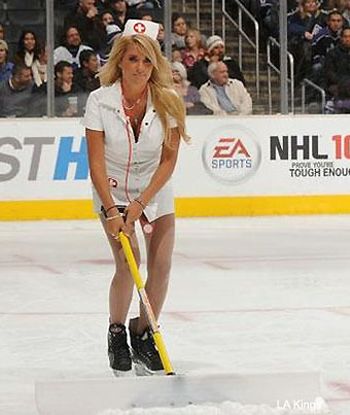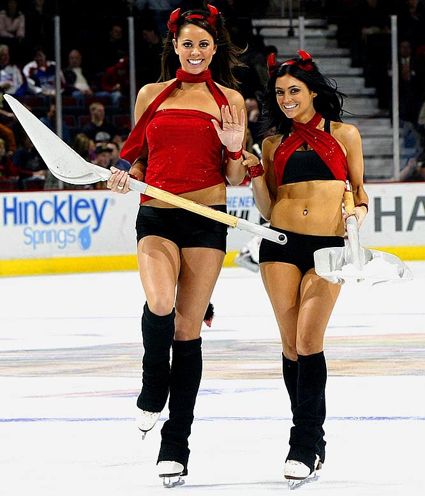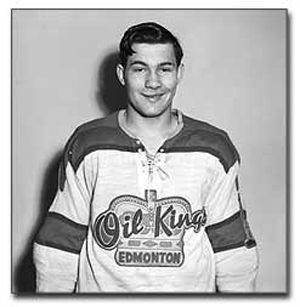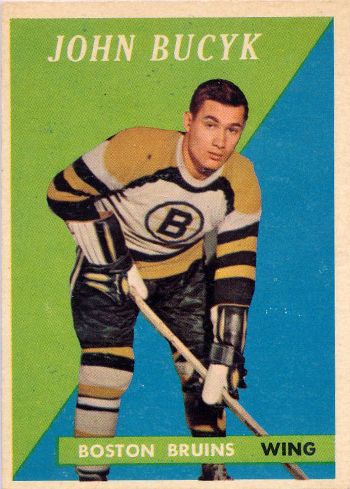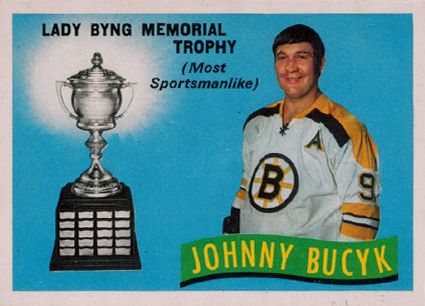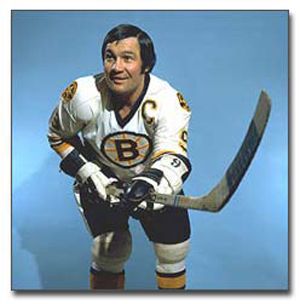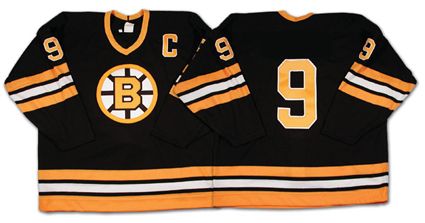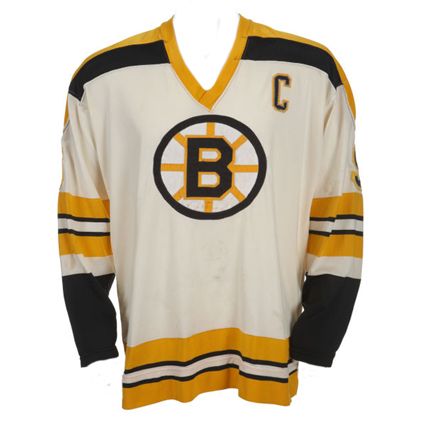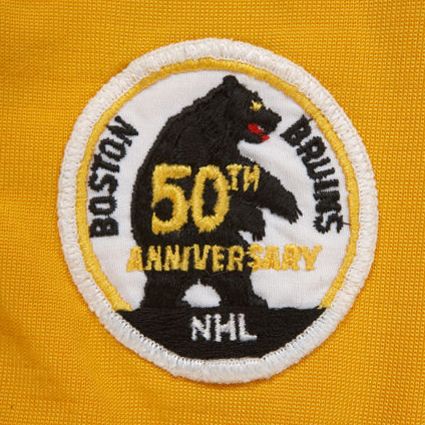is joined by Olmstead, who assisted on all four of his goals
Saturday, November 5, 2016
1955-56 Montreal Canadiens Jean Beliveau Jersey
On this date in 1955, the Montreal Canadiens and Boston Bruins squared off at The Forum in Montreal.
The Bruins jumped out to an early lead with an even strength goal by Leo Boivin at 1:35 of the first period. Before the period would end, Doug Mohns would add to the Bruins advantage with a power play goal at the 18:12 mark. Before the period would end, Cal Gardner
of Boston would be whistled for a penalty with just ten seconds
remaining that would put Montreal on the power play to start the second
period.
With Montreal already with a man advantage, Hal Laycoe
would be called for a penalty at the 16 second mark that would change
the way the game would be played forever more. The Canadiens relished
any opportunity to play with a man advantage, for the previous season
they led the league in goals with 228 in 70 games, the only team to
average more than 3 per game and 24 more than their closest pursuer
thanks to their notoriously potent power play.
Montreal controlled the puck following the face-off and Doug Harvey fed Bert Olmstead who got the puck to center Jean Beliveau who redirected it past Bruins goaltender Terry Sawchuk at the 42 second mark to cut the Bruins lead to 2-1.
After the ensuing face-off, with Montreal still on the power play, Maurice Richard worked to get the puck to Olmstead, who again fed Beliveau who once more beat Sawchuk on a similar play just 26 seconds later to even the score at 2-2.
Now,
in this day and age, the first Montreal goal would have freed Gardner
from the penalty box while the second tally would have set Laycoe free,
ending the Montreal man advantage, but this was not the case back in
1955, as any penalized player was required to serve the full length of
his penalty, regardless of how many goals were scored while his full
time was being served.
So, with
both Gardner and Laycoe still serving their full sentence with no parole
in the offing, Montreal remained on a two-man advantage with 42 seconds
remaining. After controlling the puck once again, Harvey again found
Olmstead who knew exactly what to do with it - get the puck to Beliveau.
"Le Gros Bill" found the twine to complete his hat trick at 1:26, his
third goal with the two man advantage in the span of just 44 seconds!
Gardner
was finally able to escape the penalty box 24 seconds later after
having to helplessly watch the carnage created by his departure, and
Laycoe's freedom finally arrived 26 seconds later, but not until he was
forced to watch a 2-0 Boston lead turned into a 3-2 lead for the
Canadiens while he was away.
While
there were no further power play goals during the contest, Beliveau
would score his fourth goal of the night at 15:53 of the third period at
even strength, assisted by Olmstead once again and Bernie Geoffrion for a final score in favor of Montreal 4-2 thanks to the talents of Beliveau and the remarkable Canadiens power play.
Beliveau displays the four pucks from his stellar evening and
is joined by Olmstead, who assisted on all four of his goals
is joined by Olmstead, who assisted on all four of his goals
Beliveau
would go on to go on to win the Art Ross Trophy as scoring champion and
the Hart Trophy
as league MVP at the conclusion of the season, thanks
in part to the opportunity to score multiple goals on a single power
play.
Such was the dominance
of the Montreal power play, having scored more than once with the man
advantage eight times that season, that a new rule was put into effect
in time for the start of the 1956-57 season to minimize the distinct
offensive advantage enjoyed by the Canadiens, as any penalized player
serving a two-minute minor would be freed immediately following any goal
scored against his team in an effort to keep games more competitive.
Predictably, the vote was 5-1 in favor of the new rule change.
While
Montreal was able to capture the Stanley Cup in 1956 with the ability
to score seemingly at will with the man advantage, how did the new rule
affect the competitive balance for the time period immediately after the
new rule was put into effect? Very little, in fact, as the Canadiens
would reel off four more consecutive titles from 1957 to 1960 for a
dynasty like no other, as no team before or since would ever win five
consecutive Stanley Cups.
Today's featured jersey is a 1955-56 Montreal Canadiens Jean Beliveau jersey.
Believau was a staggering ten time Stanley Cup champion with Montreal in his 20
years with the club. Beliveau also won
the Art Ross Trophy as scoring champion in 1956, the Hart Trophy as MVP in 1956 and 1964 and the inaugural Conn Smythe Trophy in 1965. Had the Conn Smythe Trophy been in existence
prior to the 1965 finals, odds are that Beliveau would have won at least
one other one, particularly in 1956 when he led the Canadiens in
playoff scoring with 12 goals and 19 points in just ten games.
This
exact variation of the Canadiens jersey arrived in 1947 when the red
shoulders no longer encroached into the blue arm stripes and would be
worn until 1956 when further detail changes were introduced.
Today's video selection is the wonderful Legends of Hockey profile of Beliveau.
Labels:
Beliveau Jean,
Montreal Canadiens
Friday, November 4, 2016
1997-98 New York Islanders Eric Fichaud Jersey
Born on this date in 1975, Eric Fichaud played his junior hockey with the Chicoutimi Sagueneens of the Quebec Major Junior Hockey League beginning in the 1992-93 season. After posting a record of 18-15-1, he took the undisputed number one role in 1993-94, and in 63 starts, went 37-21-3. He backstopped the Sags to the QMJHL championship after winning 16 of 26 playoff games to earn the club a spot in the Memorial Cup.

Today's video selection is a slideshow of images from Fichaud's career, which documents many of the jerseys he wore during his career.
Fichaud during his junior days with the Chicoutimi Sagueneens
Following the season Fichaud was drafted 16th overall by the Toronto Maple Leafs before returning to Chicoutimi for one final season during which he recorded his third consecutive winning season with a 21-19-4 mark.
The Maple Leafs traded Fichaud to the New York Islanders at the 1995 draft and he spilt the 1995-96 season between the Worcester Ice Cats of the AHL and the Islanders, who were in a decidedly down period at the time. Fichaud's rookie season ended with a 7-12-2 record, but a respectable 3.31 goals against average.
Fichaud in the Islanders controversial Fishsticks jersey
His second season on Long Island saw his games played increase from 24 to 34 as he complied a 9-14-4 record while lowering his goals against average to 3.10. Following the season he was selected to join Team Canada for the 1997 World Championships, but did not see any action.

Fichaud in the Islanders hybrid jersey, as the classic logo
replaced the Fisherman cresting on the new jersey style
replaced the Fisherman cresting on the new jersey style
Fichaud saw limited playing time in 1997-98 thanks to a shoulder injury, playing 17 games with the Islanders, finishing with a 3-8-3 mark but lowering his GAA once more, down to 2.97, and a single game with the Utah Grizzlies of the IHL.
During the off season, he was dealt to the Edmonton Oilers in June, only to have the Oilers deal him to the Nashville Predators in early October. He once again saw little ice time, playing 8 games with Milwaukee (5-2-1) and a forgettable 9 games with the Predators, going 0-6-0 while competing for playing time with Mike Dunham and Tomas Vokoun.
His next stop was with the Carolina Hurricanes, where once more ice time was at a premium. 9 games with Carolina ended with his release and he was claimed by the Montreal Canadiens who assigned him to the Quebec Citadelles of the AHL, where he performed well with a 4-1-1 mark.
He finally got his first regular ice time in four seasons in 2000-01 with the Citadelles, seeing action in 42 games and finishing with a 19-19-2 record.
Fichaud while with the Quebec Citadelles of the AHL
For the 2001-02 season, Fichaud started the year with the Manitoba Moose, but was granted his release by the Moose after just 5 games in three months. He signed with the Krefeld Penguins of the German DEL and played in 9 regular season games as well as 3 playoff contests.
Back in North America for the 2002-03 season, Fichaud played with the Hamilton Bulldogs, the top affiliate of the Oilers. He had a good season with a strong Bulldogs club, splitting time with Mathieu Garon and Ty Conklin on his way to 27 appearances and a 14-7-3 mark with 4 shutouts, his highest total since juniors. He also played in 8 playoff games with a 5-3 record as Hamilton made it to the Calder Cup Finals.
Back in North America, Fichaud had a solid season with Hamilton
He was back for a second season with the Bulldogs, only now part of the Canadiens organization, and in 31 games went 16-11-3.
Beginning with the 2004-05 season, Fichaud started a three year run with Quebec RadioX (named after a radio station owned by the team's owners) of he lower level Ligue Nord-Americaine de Hockey after it elevated itself from being an amateur league. The 2004-05 season was the missed NHL season due to the lockout, and with hundreds of pros looking for work in Europe and many younger NHLers keeping busy in the AHL, work was hard to come by for many, who saw the LNAH as an alternative. It paid off, as RadioX won the league championship in 2005 thanks in part to Fichaud's 8-0 record during the playoffs.
After two more seasons with Quebec, Fichaud played one final season in 2007-08 with the St. Georges CRS Express.
Today's featured jersey is a 1997-98 New York Islanders Eric Fichaud jersey.
The Islanders new ownership, in an effort to attract new, younger fans
to the downtrodden Islanders scrapped their traditional sweaters, which
only happened to have been worn not only since the club's inception in
1972, but also for the length of their Stanley Cup dynasty, and
introduced their new jerseys for the 1995-96 season.
Bonus Jersey: Today's bonus jersey is a 1999-00 Quebec Citadelles Eric Fichaud jersey as worn during his first season with the Canadiens AHL affiliate.
As the team wallowed in the depths of the NHL standings and traded away fan favorite Pierre Turgeon for the disgruntled Kirk Muller,
the fan base immediately made the new jerseys, and specifically their
new fisherman logo, the focus of their growing unhappiness. The fate of
the jersey was not made any better when the rival New York Rangers fans
began to mock the new jerseys with chants of "We want fishsticks! We want fish sticks!" in reference to the new logo's resemblance to the Gorton's Fisherman logo.
The
Islanders adopted a hybrid jersey for 1996-97 with the original
Islanders logo placed on the "wave" style jersey as an alternate style.
For 1997-98, the fisherman was gone and the hybrid jersey was used full
time. In 1998-99, a modern version of the Islanders jersey debuted as
the wave style was scrapped permanently.
This attractive jersey features the unusual choice of a goat head for the team's logo, which was the mascot of the Royal 22nd Regiment, which was stationed in the Citadel of Quebec. The team played in Quebec for just three seasons before relocating to Hamilton where they were renamed the Bulldogs.
A well travelled franchise, it began in 1969 in Montreal as the Voyageurs before moving to Nova Scotia, then Sherbrooke, Quebec and then Frederiction before relocating for the fourth time to Quebec.
Labels:
Fichaud Eric,
New York Islanders,
Quebec Citadelles
Wednesday, November 2, 2016
1978-79 Edmonton Oilers Wayne Gretzky Jersey
Having only played eight games for the Indianapolis Racers, on this date in 1978, Wayne Gretzky was sold to the Edmonton Oilers.
At the time, the NHL had rules in place not allowing players under the age of 20 to be signed and the WHA, in an attempt to beat the NHL to some of the best upcoming young talent, started signing underage players, most of whom were 19 years old.
Today's featured jersey is a 1978-79 Edmonton Oilers Eddie Mio jersey. This is the road blue version of today's featured jersey from the man whose credit card may have changed hockey history!
Our first video today is about Gretzky's time in the WHA, including his time with Indianapolis.
With the Racers losing $40,000 per game, owner Nelson Skalbania, having pulled a coup by being the one to land the then 17-year-old Gretzky, knew the Racers demise was a foregone conclusion. Skalbania's hope was to keep the Racers around long enough for a merger with the NHL to happen, knowing the Racers would not be a part of it, with the goal of being compensated financially for folding his team.
Other than the team itself, Skalbania's other main asset was Gretzky, and selling him would be the quickest way to raise some much needed cash.
Skalbania's options for moving Gretzky were the Edmonton Oilers or the Winnipeg Jets. In the end, Gretzky, goaltender Eddie Mio and forward Peter Driscoll were put on a chartered Lear jet, not knowing where they would land or which team they would join!
To add to the absurdity of the situation, Skalbania had not arranged payment for the flight. Mio produced a credit card that had only a $500 limit, which the pilot accepted and took off, heading for Minneapolis.
While the trio was up in the air, both literally and figuratively(!), Skalbania worked out a "deal" with his former partner Oilers owner Peter Pocklington, said to be a backgammon game with Gretzky as the prize should Pockington win. And win he did, and the plane was directed to land in Edmonton, changing the future of hockey. The deal that sent Gretzky, Mio and Driscoll to the Oilers was announced at $850,000, but Pocklington reportedly only paid $700,000,
Once on the ground in Edmonton, the pilot decided to hold out for full payment of the $7,900 until Pockington was able to be contacted and assured everyone that the Oilers would be taking care of the bill, much to the relief of Mio, who had his credit card receipt torn up.
"I should have kept [the receipt]," said Mio. "That would have made a great souvenir."
To add to the absurdity of the situation, Skalbania had not arranged payment for the flight. Mio produced a credit card that had only a $500 limit, which the pilot accepted and took off, heading for Minneapolis.
While the trio was up in the air, both literally and figuratively(!), Skalbania worked out a "deal" with his former partner Oilers owner Peter Pocklington, said to be a backgammon game with Gretzky as the prize should Pockington win. And win he did, and the plane was directed to land in Edmonton, changing the future of hockey. The deal that sent Gretzky, Mio and Driscoll to the Oilers was announced at $850,000, but Pocklington reportedly only paid $700,000,
Pocklington and Skalbania
Once on the ground in Edmonton, the pilot decided to hold out for full payment of the $7,900 until Pockington was able to be contacted and assured everyone that the Oilers would be taking care of the bill, much to the relief of Mio, who had his credit card receipt torn up.
"I should have kept [the receipt]," said Mio. "That would have made a great souvenir."
The Racers would not survive long enough for Skalbania to be bought out as he had hoped, folding just 17 games later on December 15, 1978, three and a half months short of his goal of making to the end of the season. The Oilers and Jets, along with the New England (Hartford) Whalers and Quebec Nordiques would join the NHL at the start of the next season. Of note, the two WHA teams not invited to join the NHL, the Cincinnati Stingers and Birmingham Bulls, each received $1.5 million as compensation.
After having the move out of Indianapolis completed, Gretzky would settle in with the Oilers and on his 18th birthday in January 26th of that season, he would sign a 10 year contract with Pocklington. He would finish third in WHA scoring with 46 goals and 64 assists for 110 points behind only Real Cloutier and Robbie Ftorek and be named the recipient of the forgotten Lou Kaplan Trophy as the WHA Rookie of the Year.
On his 18th birthday in January of 1979, Gretzky signed
a 10 year contract with Pocklington for $3 million
Today's featured jersey is a 1978-79 Edmonton Oilers Wayne Gretzky jersey. During the frachise's first season of play in the WHA as the Alberta Oilers, all the player's jerseys initially had "ALBERTA" on the back instead of the individual player names. Before the 1972-73 season was complete, the team changed to using the players names on their home white and road orange jerseys, which are now being worn by the club as a throwback alternate style.
After two seasons the orange jerseys were replaced by their now customary blue jerseys, only now with ill-advised and hard to read cresting with blue letters on an orange background on their home white jerseys and low contrast orange letters on a white background on their road blue jerseys as seen in today's featured jersey worn during Gretzky's rookie season in the WHA following his departure from Indianapolis. While the Oilers made the logo harder to read, the did reverse the colors of the numbers on their white jerseys from orange outlined in blue to blue outlined in orange.
The Oilers jerseys would remain unchanged from 1974-75 for the rest of their time in the WHA, but when the Oilers joined the NHL in 1979-80, they changed the colors of their crest for the better, to the original blue letters on a white background with an orange oil drop as used during their first two seasons in the WHA that they never should have gotten away from in the first place.
After two seasons the orange jerseys were replaced by their now customary blue jerseys, only now with ill-advised and hard to read cresting with blue letters on an orange background on their home white jerseys and low contrast orange letters on a white background on their road blue jerseys as seen in today's featured jersey worn during Gretzky's rookie season in the WHA following his departure from Indianapolis. While the Oilers made the logo harder to read, the did reverse the colors of the numbers on their white jerseys from orange outlined in blue to blue outlined in orange.
The Oilers jerseys would remain unchanged from 1974-75 for the rest of their time in the WHA, but when the Oilers joined the NHL in 1979-80, they changed the colors of their crest for the better, to the original blue letters on a white background with an orange oil drop as used during their first two seasons in the WHA that they never should have gotten away from in the first place.
Today's featured jersey is a 1978-79 Edmonton Oilers Eddie Mio jersey. This is the road blue version of today's featured jersey from the man whose credit card may have changed hockey history!
photo courtesy of Classic Auctions
Here is a behind the scene's look at Gretzky from a documentary from the 1980's called "The Boys on the Bus" that is a change of pace from the usual game highlights.
Labels:
Edmonton Oilers,
Gretzky Wayne
Tuesday, November 1, 2016
All Saints Day
October 31st, Halloween, is sometimes referred to as "All Hallows Eve", making November 1st "All Hallows", with "hallows" being defined as "to consecrate or set apart as being holy". Thus, All Hallows celebrates all those who have been set apart as being holy by being named to sainthood, which leads to another name for All Hallows - "All Saints' Day".
A search of HockeyDB.com reveals twenty teams named "Saints" at various levels of hockey as far back as 1925 with the original incarnation of the St. Paul Saints of the Central Hockey League. The Saints then moved to the American Hockey Association for four seasons, back to the CHL for four, which included winning the league championship in 1935, and once more back to the AHA for seven seasons until World War II brought a temporary halt to the league. When play resumed in 1945, the Saints were now part of the United States Hockey League until 1955 and took home the championship in 1949.
The 1948-49 USHL champion St. Paul Saints
In 1959 the St. Paul Saints name would be revived with a new franchise in the International Hockey League, which would continue play through 1963 until their name was changed to the St. Paul Rangers to reflect their affiliation with the NHL's New York Rangers. This edition of the Saints was quite successful, appearing in the Turner Cup Finals three consecutive seasons, winning championships in both 1960 and 1961 and having their reign ended in 1962.
The 1960 IHL Champion St. Paul Saints
Next on the scene was the St. Catharines Saints in 1940 in the Ontario Hockey Association in Canada. That club lasted only two seasons, but the name was revived in 1982 when a new club joined the American Hockey League in 1982. That club stayed for four seasons prior to a relocation to Newmarket, Ontario where they were now known as the Newmarket Saints until 1991. After another relocation resulted in a name change, followed by yet another in 2005 which currently has them known as the Toronto Marlies.
A little known club in Minnesota called the Hibbing Saints played for one season in the Northern Hockey League. The fourth Saints franchise was the Sherbrooke Saints of the Quebec Senior Hockey League from 1949 to 1954.
The St. Boniface Saints had a long run in the Manitoba Junior Hockey League from 1967 to 2001 before new owners renamed them the Winnipeg Saints where they continue to play in Canadian Tier II Junior "A" hockey.
The 1992-93 St. Boniface Saints
Also formed in 1967, the Windsor St. Clair Saints played in the Ontario Colleges Athletic Association and dominated with championships in 1968, 1969, 1970, 1973, 1975, 1976, 1977 and 1979. They also won the Canadian Colleges Athletic Association National Championship in 1976.
After an extended break from competition, the St. Clair Saints returned in 2001 and won the OCAA championship in 2002 and 2003. Following the demise of the OCAA, the Saints eventually joined Major League Hockey, playing against Senior AAA level teams from 2006 to 2008 before ceasing operations.
The St. Claire Saints pay a hospital visit in 2008
The Laval Saints of the Quebec Major Junior Hockey League lasted but one season in 1969-70.
The next club to arrive on the scene with the Saints name did so with a twist. As founding members of the World Hockey Association in 1972 based in St. Paul, Minnesota, the new club elected to call themselves the Minnesota Fighting Saints. They created one of the best logos hockey has ever seen, which has been copied again and again since then. The Fighting Saints also played a firey, uptempo brand of hockey with plenty of fisticuffs and occasional mayhem thrown in to live up to the team name.
Competing with the NHL's Minnesota North Stars, who were in a down period on the ice at the time, the always competitive Fighting Saints captured the hearts of the Minnesota hockey fans and played to several record setting capacity crowds of over 17,000 at their brand new St. Paul Civic Center on the current site of the Minnesota Wild's Xcel Energy Center.
The 1973-74 Minnesota Fighting Saints
The Fighting Saints lasted four seasons in the unstable WHA and never missed the playoffs or had a losing record. After the original blue-clad WHA Fighting Saints folded during the 1975-76 season, the Cleveland Crusaders relocated to St. Paul for 1976-77 and adopted the Fighting Saints name and logo, but changed their primary color to red to differentiate themselves from the original club. This version of the Fighting Saints lasted only 42 games before also calling it quits.
Surprisingly, there haven't been more teams from St. Louis named the Saints, but there was one such club, the St. Louis Saints, which competed in the Continental Hockey League for two years starting in 1974.
The tenth Saints club, a junior hockey team from Ecorse, Michigan named the Paddock Pool Saints was active from 1975 to 1984 in the Great Lakes Junior Hockey League. The St. Albert Saints (1977-2004) were members of the Alberta Junior Hockey League, not to be confused with the Saskatchewan Junior Hockey League's Prince Albert Saints, who played in 1980-81.
Despite their short life, the Minnesota Fighting Saints popularity influenced several subsequent teams at various levels, including the Dubuque Fighting Saints (1980-2001) of the United States Hockey League, the Danville Fighting Saints (1986-1989) of the All American Hockey League and the St. Paul Fighting Saints (1992-93) of the American Hockey Association. A new version of the Dubuque Fighting Saints began play in the USHL in 2010-11 and immediately won the USHL championship in 2011 and again in 2013.
Going overseas, the Glasgow Saints of Scotland competed in the British Hockey League during the 1990-91 season, but failed to survive beyond that.
The San Angelo Saints who were members of the Central Hockey League from 2002-2005 and the Spruce Grove Saints of
the Alberta Junior Hockey League are the relocated St. Albert Saints a
franchise which can be traced back to 1963 with several different names.
Spruce Grove is currently riding a wave of success, having made the
league finals the last four seasons in a row, winning back-to-back
championships in 2014 and 2015.
The 2009-10 Spruce Grove Saints
The New York Saints of the Metropolitan Junior Hockey League arrived in 2006, but lasted just a single season. Finally, the St. Clair Shores Fighting Saints began play this season in the Federal Hockey League, a minor pro league in the Midwest and Northeast.
Today's featured jersey is a 1972-73 Minnesota Fighting Saints Ted Hampson jersey. Hampson had a long career in hockey which began with the Flin Flon Bombers in junior hockey in 1954-55 and included winning the Memorial Cup in 1957. He criss-crossed North America, playing for Providence in the AHL and Vancouver in the WHL and then back to Rochester, New York of the AHL before making his NHL debut with the Toronto Maple Leafs in 1959-60. He then played three seasons with the New York Rangers from 1960-61 to 1962-63 before a move to the Detroit Red Wings organization.
His first three seasons were spent mainly with the Pittsburgh Hornets of the AHL before playing in Detroit in 1966-67 and half of 1967-68 before a trade sent him to the Oakland Seals, where he would be named the second ever recipient of the Bill Masterton Trophy at the conclusion of the season for perseverance, sportsmanship and dedication to hockey.
Hampson would play three more seasons with Oakland, including setting an NHL career best with 26 goals and 75 points and appearing in the NHL All-Star Game in during the 1968-69 season before being dealt late in the 1970-71 season to the Minnesota North Stars. After playing the 1971-72 season with the North Stars, Hampson would move across the river to St. Paul to join the brand new Fighting Saints of the WHA for the league's debut season of 1972-73, where Hampson would be named the team's captain due to his veteran leadership and win the WHA's first "Most Gentlemanly Player" Award.
After three and a half seasons the Fighting Saints would fold due to financial difficulties. Hampson them finished out the 1975-76 season with the Quebec Nordiques. After sitting out two seasons, he would return to the ice in 1978-79 with the Oklahoma City Stars of the CHL for 23 games and make token appearances of 3 and 6 games in 1979-80 and 1980-81 before his playing days were completed for good.
His first three seasons were spent mainly with the Pittsburgh Hornets of the AHL before playing in Detroit in 1966-67 and half of 1967-68 before a trade sent him to the Oakland Seals, where he would be named the second ever recipient of the Bill Masterton Trophy at the conclusion of the season for perseverance, sportsmanship and dedication to hockey.
Hampson would play three more seasons with Oakland, including setting an NHL career best with 26 goals and 75 points and appearing in the NHL All-Star Game in during the 1968-69 season before being dealt late in the 1970-71 season to the Minnesota North Stars. After playing the 1971-72 season with the North Stars, Hampson would move across the river to St. Paul to join the brand new Fighting Saints of the WHA for the league's debut season of 1972-73, where Hampson would be named the team's captain due to his veteran leadership and win the WHA's first "Most Gentlemanly Player" Award.
After three and a half seasons the Fighting Saints would fold due to financial difficulties. Hampson them finished out the 1975-76 season with the Quebec Nordiques. After sitting out two seasons, he would return to the ice in 1978-79 with the Oklahoma City Stars of the CHL for 23 games and make token appearances of 3 and 6 games in 1979-80 and 1980-81 before his playing days were completed for good.
If the Fighting Saints jersey appears familiar at first glance, is probably is, as the Fighting Saints minor league affiliate the Johnstown Jets was the inspiration for the Charlestown Chiefs of the famed move "Slap Shot", and the movie Chiefs wore jerseys of the same color and striping template as Johnstown, who mimicked the jerseys of their parent club, the Fighting Saints.
This jersey was actually not the original Fighting Saints jersey, as they began play with jerseys featuring a large "S" logo before a second set of jersey featuring the "Little Saint" logo was put into use.
Bonus Jersey: Today's bonus jersey is a 1975-76 Minnesota Fighting Saints Dave Keon jersey. After
Keon came to an agreement to join the Ottawa Nationals of the fledgling
WHA in 1972, the deal fell apart and he signed a three year contract to
remain in Toronto and led the team in goal scoring in 1972-73, which
included his 297th goal as a Maple Leaf, passing George Armstrong and Frank Mahavolich as the franchise's all-time leading goal scorer.
Having fallen out of favor with Maple Leaf's owner Harold Ballard by
the end of his contract, Keon jumped to the rival WHA and signed with
the Minnesota Fighting Saints. When the Fighting Saints folded, Keon was
unable to return to the NHL because the Maple Leafs still held his NHL
rights and owner Ballard wanted too steep a level of compensation from
any NHL club signing him, effectively locking Keon out of the NHL.
With
only the WHA as an option, Keon signed with the Indianapolis Racers for
the remainder of the season. He was traded to the new incarnation of
the Minnesota Fighting Saints for the following season, only to see that
version of the franchise again fold during before the completion of the
season. He once more found some stability when he joined the WHA's New
England Whalers, where he would play for the remainder of his career,
three seasons in the WHA and three more finally back in the NHL
following the merger in 1979.
It was during the 1979-80 season that Keon, then 40 years old, was occasionally on a line with both Gordie Howe (age 50) and Bobby Hull (age
41). When both Howe and Hull retired, Keon was the oldest player in the
NHL for his final two seasons before retiring after the 1981-82 season
at age 42.
Keon's
final totals were 396 goals and 590 assists for 986 NHL points and
another 102 goals and 189 assists for 291 points in the WHA, the Calder
Trophy, two Lady Byng Trophies, a Conn Smythe Trophy, eight NHL All-Star
Game appearances and four Stanley Cups as well as being inducted into
the Hockey Hall of Fame in 1986.
Extra bonus jersey: Today's extra bonus jersey is a 1984-85 St. Catharines Saints Gary Leeman jersey. Leeman was a ten year member of the Toronto Maple Leafs of the NHL, but did play 7 and then 25 games over two seasons with St. Catharines of the AHL early in his career. Leeman would later go on to win a Stanley Cup with the Montreal Canadiens in 1993 and score 466 points in 667 NHL games.
photo courtesy of Classic Auctions
This jersey clearly reflects the then current style of the Saints parent club, the Toronto Maple Leafs. While copying the parent club's jersey style was the norm back then, many minor league clubs have learned the value of having their own separate identity when it comes to their own income through sales of unique merchandise and jerseys.
photo courtesy of Classic Auctions
Today's video segment is a peek into the crazy world of the Minnesota Fighting Saints of the WHA, when one of the players beat up his own coach!
This second video is a highlight film of the Fighting Saints first season of 1972-73. Notice the gold alternate jerseys with the original "S" logo, none of which are known to have survived, as the logos were removed and they were handed down to a local high school who shared the same colors.
Once the Little Saint logo appeared on their jerseys, they Fighting Saints limited themselves to just home white and road blue jerseys.
Another thing to be aware of are the unique clear boards used in the St. Paul Civic Center, which allowed fans a view of the puck at all times, particularly those fans in the first several rows of seats, which were set back from the boards by a fair distance due to the round layout of the Civic Center.
If you are interested in some rare St. Paul Saints for Minnesota Fighting Saints jerseys, our friends at VintageMinnesotaHockey.com have a series of excellent reproductions of not only the WHA's Minnesota Fighting Saints, more accurate than anything found anywhere else online, but also a series of St. Paul Saints jerseys from the minor league club from the 1930's to the 1960's. Just do a search for "Saints" to view your options.
Monday, October 31, 2016
Happy Halloween!
Quite often in the minor leagues teams will create special one-off jerseys for various special occasions such as theme nights, tribute nights or holidays, such as Valentine's Day, New Year's Eve or today's annual observation of Halloween.
The jersey production method of dye-sublimation, which allows for all manner of intricate details to be printed onto jerseys, lends itself perfectly to they eye-catching, or occasionally eye-searing, special occasion jerseys.
Two of the best Halloween jerseys we've ever seen are the efforts by the 2009-10 Hannover Indians of the 2nd Bundesliga, the second level of German professional hockey, in 2009 and the 2008 creation of the Binghamton Senators of the American Hockey League.
This 2009-10 Hannover Indians Halloween jersey, as worn by American Nick Martens, is a downright spooky affair, featuring a series of skeletons, some with feathers on their heads in keeping with the team's nickname, wandering through a graveyard as a large flock of bats circles overhead at sundown. The primary skeleton even sports a hockey stick, showing some thought went into this design and it just wasn't some clip art chosen because it fit the Halloween theme.
Another well chosen element was the choice of the always creepy but fun font "Blood of Dracula" for the player's names and numbers, as well as the team name on the back and the motto on the front of the jersey reads "Indians geben niemals auf!", which translates to "Indians never give up!", which is additionally appropriate for the walking dead.
Fortunately for the jersey designer, the club's main sponsor, Kofler Energies, just happens to have the appropriate orange and black as their corporate colors!
The other favorite jersey on our list is the 2008-09 Binghamton Senators Halloween jersey, as worn by center Zack Smith, who is currently playing for the parent club, the Ottawa Senators of the NHL.
Rather than making the expected black jersey, the Senators opted for a lighter jersey which features many of the usual Halloween icons, such as the jack o' lanterns on the lower sleeves, a spooky castle with circling bats and a large spider on the lower body, whose subtle web covers the majority of the jersey. The look is completed by choosing the font Ironwood, which evokes thoughts of a Gothic dungeon in a spooky castle.
Even the team's main crest doesn't seem out of place, as the angry, cartoonish Senator on the front is rather scary looking and the colors aren't too far off from the color palette of the rest of the package.
While many of the top professional leagues have not embraced the use of special occasion jerseys for games, at times NHL clubs have been known to occasionally create a unique set of jerseys worn in pre-game warmups, like those worn by the San Jose Sharks in 2007 and the New York Islanders in 2009, which were later auctioned off for charity, with John Tavares' jersey raising $1,701.79.
The San Jose Sharks 2007 Halloween themed warmup jersey
The New York Islanders 2009 Halloween themed warmup jersey
The Sharks once again created a special Halloween jersey in 2012 and wore it in pregame warmups. They jerseys were then auctioned off on October 27th and 30th, with one remaining one being sold through NHL Auctions.
The San Jose Sharks 2010 Halloween themed practice jersey
Even if clubs in the NHL choose not to wear special jerseys on this day, it's at least an opportunity for their ice girls to have some fun and dress up in costume.
Today's video segment features the man who did more to make the goalie mask famous than Jacques Plante, Jason Voorhees in a surreal interview with Arsenio Hall.
Next, the Florida Panthers Ice Dancers performance from Halloween 2009. Full credit must be given for doing those high kicks on ice without wiping out. Just how do they do that?
Here's a quick video with some of the best costumes worn to games by NHL fans.
Next, then Toronto Maple Leafs general manager Brian Burke and crew perform a Halloween favorite with the help of "The Monster", Jonas Gustavsson.
Next, then Toronto Maple Leafs general manager Brian Burke and crew perform a Halloween favorite with the help of "The Monster", Jonas Gustavsson.
Finally, a tribute to the Boogeyman, the late Derek Boogaard, on Halloween.
Sunday, October 30, 2016
1975-76 Boston Bruins Johnny Bucyk Jersey
Johnny Bucyk ranks as one of the most successful yet overlooked hockey players in NHL history.
He began his road to the NHL in 1951 when he joined the Edmonton Oil Kings of the Western Canadian Junior Hockey League for a single playoff game. He returned to the Oil Kings for the next two seasons, scoring 67 points in 33 games in 1954 and went on to win the prestigious Memorial Cup before moving up to the Edmonton Flyers of the Western Hockey League for the 1954-55 season, scoring 30 goals and 88 points in 70 games.
His arrival in Boston back in 1957 would begin an affiliation with the organization that continues today, more than 50 years later. While it looked at first that Bucyk had arrived in Boston at a good time, evidenced by going to the Stanley Cup Finals in his first season in Boston, things would quickly turn sour for the club following a first round elimination in the 1959 playoffs, as the Bruins would spend the majority of the 1960's out of the playoffs, missing the postseason eight consecutive years, five of which were as the league's doormat buried in last place waiting for the arrival of Bobby Orr and Phil Esposito
Still, Bucyk's personal numbers were incredibly consistent throughout, as eight of his ten seasons were between 52 and 66 points. During that period, Bucyk, a big player for his era a 6', 215 lbs., led the Bruins in scoring in 1962, 1963, 1965 and 1967, a season in which he was team captain.
1966-67 was also the season that the Bruins would begin to climb out of the depths with the arrival of Orr, followed by Esposito the following season. Bucyk would never again lead the Bruins in scoring, but the arrival of Orr and Esposito would ignite a scoring revolution that would propel Bucyk to personal bests never before imagined.
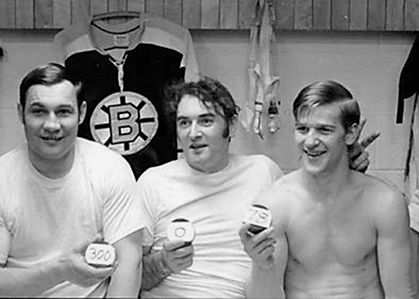
In a hilarious photo, Johnny Bucyk poses with goaltender Eddie Johnston and Bobby Orr as they pose with pucks indicating their career goal totals, Bucyk having just reached 300, Johnston still stuck at zero and Orr at 78!
Esposito's first season with Boston saw Bucyk reach 30 goals for the first time ever and eclipse his personal best season total with 69 points as the Bruins returned to the playoffs for the first time since the 1950s. Two seasons later he would equal the 69 points, but raise his goal total to 31. During the postseason, 11 more goals would follow as Bucyk scored 19 points in 14 games as the Bruins won their first Stanley Cup in 29 years. As the Bruins had no captain from 1967 to 1973, Bucyk, as the assistant captain with the greatest seniority, was the first to hoist the cup during the championship celebration.
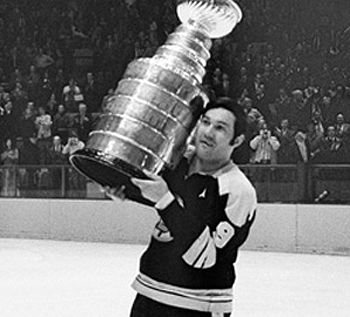
What sets this Bruins jersey apart is the lack of not only the colored shoulders of the previous style, discontinued for the 1974-75 season, but also the lack of the bear head shoulder patches, which would arrive for the following 1976-77 campaign and would remain in place all the way through the 1994-95 season. Names on the back would not arrive until the 1977-78 season.
All of that adds up to today's featured jersey variation of completely blank shoulders only being used for just two seasons, 1974-75 and 1975-76, the season of Bucyk's 500th goal.
Bonus jersey: Today's bonus jersey is a 1973-74 Boston Bruins Johnny Bucyk jersey, as worn the season Bucyk won his second Lady Byng Trophy.
This jersey features the Bruins 50th Anniversary patch, the first commemorative patch of the modern era. The last patch worn on an NHL jersey prior to the Bruins 50th Anniversary patch was back in 1951-52, a gap of 22 seasons. By the end of the decade ten more patches had been added to NHL jerseys, including the arrival of the memorial patch, first worn by the Philadelphia Flyers in in 1977 for Barry Ashbee.
Today's video segment begins with Johnny Bucyk Night in Boston, when the celebrate his 50 years with the organization.
He began his road to the NHL in 1951 when he joined the Edmonton Oil Kings of the Western Canadian Junior Hockey League for a single playoff game. He returned to the Oil Kings for the next two seasons, scoring 67 points in 33 games in 1954 and went on to win the prestigious Memorial Cup before moving up to the Edmonton Flyers of the Western Hockey League for the 1954-55 season, scoring 30 goals and 88 points in 70 games.
Buyck while with the Edmonton Oil King

A rare shot of Bucyk in a Red Wings jersey
That performance earned Bucyk his chance to debut in the NHL with the Detroit Red Wings in 1955. Life in the NHL was not the same, as Bucyk competed in 38 games and managed just a single goal and eight assists for nine points. In his second season in Detroit he fared better, scoring 10 goals in 66 games.

A rare shot of Bucyk in a Red Wings jersey
That would prove to be the end of Bucyk's time in Detroit however, as he was traded to the Boston Bruins when the Red Wings reacquired goaltender Terry Sawchuk whom they had dealt to Boston just two years prior.
His arrival in Boston back in 1957 would begin an affiliation with the organization that continues today, more than 50 years later. While it looked at first that Bucyk had arrived in Boston at a good time, evidenced by going to the Stanley Cup Finals in his first season in Boston, things would quickly turn sour for the club following a first round elimination in the 1959 playoffs, as the Bruins would spend the majority of the 1960's out of the playoffs, missing the postseason eight consecutive years, five of which were as the league's doormat buried in last place waiting for the arrival of Bobby Orr and Phil Esposito
An early Bucyk hockey card following his trade to Boston
Still, Bucyk's personal numbers were incredibly consistent throughout, as eight of his ten seasons were between 52 and 66 points. During that period, Bucyk, a big player for his era a 6', 215 lbs., led the Bruins in scoring in 1962, 1963, 1965 and 1967, a season in which he was team captain.
1966-67 was also the season that the Bruins would begin to climb out of the depths with the arrival of Orr, followed by Esposito the following season. Bucyk would never again lead the Bruins in scoring, but the arrival of Orr and Esposito would ignite a scoring revolution that would propel Bucyk to personal bests never before imagined.

In a hilarious photo, Johnny Bucyk poses with goaltender Eddie Johnston and Bobby Orr as they pose with pucks indicating their career goal totals, Bucyk having just reached 300, Johnston still stuck at zero and Orr at 78!
Esposito's first season with Boston saw Bucyk reach 30 goals for the first time ever and eclipse his personal best season total with 69 points as the Bruins returned to the playoffs for the first time since the 1950s. Two seasons later he would equal the 69 points, but raise his goal total to 31. During the postseason, 11 more goals would follow as Bucyk scored 19 points in 14 games as the Bruins won their first Stanley Cup in 29 years. As the Bruins had no captain from 1967 to 1973, Bucyk, as the assistant captain with the greatest seniority, was the first to hoist the cup during the championship celebration.

Bucyk raises the 1970 Stanley Cup
1970-71 was a memorable one for Bucyk, as he would join the exclusive ranks of the 50 goal scorers, as he became the only the fifth player to accomplish the feat, only to be overshadowed by teammate Esposito's record shattering 76 that same season. Bucyk added 65 assists to surpass the 100 point mark for the only time in his career with 116 as Bruins Esposito (152), Orr (139), Bucyk and Ken Hodge (105) finished 1-2-3-4 in league scoring! When it came time to hand out the hardware at the conclusion of the season, Bucyk was named the recipient of the Lady Byng Trophy thanks to his season total of a mere 8 penalty minutes in 78 games.
This card commemorates Bucyk's first Lady Byng Trophy
Although his personal point totals were all down somewhat, his 83 points were still his second best season to date, his 20 points in 15 playoff games were key to the Bruins capturing the second Stanley Cup of Bucyk's career in 1972.
His offensive numbers would rise once more in 1972-73 when Bucyk scored 40 goals for only the second time in his career and his 53 assists propelled him to a 93 point season, including scoring his 1,000th career point, only the seventh player to reach that illustrious total.
He was again named team captain of the Bruins in 1973, a position he would hold until 1977. Following his 116 point season in 1971, Bucyk was a very consistent, productive player, averaging 83 points per season, and never below 75. 1973-74 saw the Bruins again return to the Stanley Cup Finals and Bucyk collect the second Lady Byng Trophy of his career after again finishing with just 9 penalty minutes. Amazingly, Bucyk was not awarded the Lady Byng in 1972, a season in which he was penalized a total of just 4 minutes, a mark equaled by the winner Jean Ratelle.
Bucyk in the classic "wide angle lens hockey pose" while captain of the Bruins
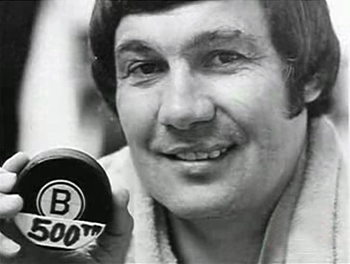
Bucyk celebrates his 500th goal
"I played physical but clean hockey," said Bucyk. "Most people think that the only reason a player wins the Lady Byng is because he is gentlemanly, but I had the ability to play physical and not draw penalties. I contributed offensively and stayed out of the penalty box."
On this date in 1975, Bucyk would again join an exclusive club when he became only the seventh player to reach 500 career goals, a tribute to his longevity, as he reached the 500 goal plateau in his 1,370th game. Of the 41 players to date to reach 500 goals, only Ron Francis would anyone require more games than Bucyk with 1533. Bucyk scored 20 goals or more in 16 of his 23 seasons.

Bucyk celebrates his 500th goal
He would play two more seasons before retiring at the age of 42 due to chronic back problems as the Bruins all-time leader in goals (556), assists (813) and points (1,369) as well as career games with 1,540. He was also the fourth leading scorer of all-time as well as the leading scorer among left wings and third in games played at the of his retirement.
The Bruins retired his #9 in 1980 and he became a member of the Hockey Hall of Fame in 1981.
"Having my Number 9 retired at the Boston Garden in 1980 was outstanding. It’s very exciting to see your number hanging there along with all the other great players. It’s the greatest honour a player can get."
Today's featured jersey is a 1975-76 Boston Bruins Johnny Bucyk jersey, as worn the season Bucyk joined the 500 goal club.
What sets this Bruins jersey apart is the lack of not only the colored shoulders of the previous style, discontinued for the 1974-75 season, but also the lack of the bear head shoulder patches, which would arrive for the following 1976-77 campaign and would remain in place all the way through the 1994-95 season. Names on the back would not arrive until the 1977-78 season.
All of that adds up to today's featured jersey variation of completely blank shoulders only being used for just two seasons, 1974-75 and 1975-76, the season of Bucyk's 500th goal.
photo courtesy of Classic Auctions
Bonus jersey: Today's bonus jersey is a 1973-74 Boston Bruins Johnny Bucyk jersey, as worn the season Bucyk won his second Lady Byng Trophy.
This jersey features the Bruins 50th Anniversary patch, the first commemorative patch of the modern era. The last patch worn on an NHL jersey prior to the Bruins 50th Anniversary patch was back in 1951-52, a gap of 22 seasons. By the end of the decade ten more patches had been added to NHL jerseys, including the arrival of the memorial patch, first worn by the Philadelphia Flyers in in 1977 for Barry Ashbee.
Today's video segment begins with Johnny Bucyk Night in Boston, when the celebrate his 50 years with the organization.
Here, Bucyk scores a goal on February 25, 1971, igniting a Bruins outburst that results in the three fastest goals in NHL history at just a lightning fast 20 seconds.
Finally, a profile of Bucyk from the excellent Legends of Hockey series.
Labels:
Boston Bruins,
Bucyk Johnny
Subscribe to:
Comments (Atom)

